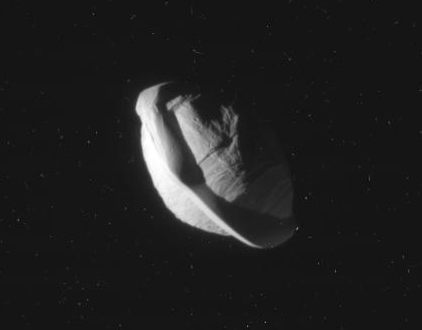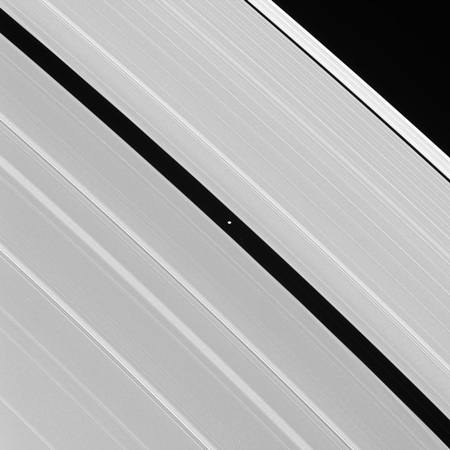It’s a flying saucer! No, a celestial empanada! Or space ravioli? Nope—the weird raw images dropped by NASA’s Jet Propulsion Laboratory this week feature Saturn’s tiny moon Pan and its equatorial fringe in unprecedented detail.
Nearing its end, Cassini delights again. Here is 35-km Pan in mind-blowing detail with its unmistakable accretionary equatorial bulge. pic.twitter.com/RdgqnH4rkJ
— Carolyn Porco (@carolynporco) March 9, 2017
The Cassini spacecraft, which has been orbiting Saturn since 2004, will crash into Saturn later this year. But its final descent brings the spacecraft closer than ever before to Saturn’s rings and offers scientists a wealth of new research opportunities.

This is because the spacecraft has entered its “ring grazing orbits,” Carolyn Porco, leader of the imaging science team for Cassini and current visiting scholar at the University of California in Berkeley, told Eos. Throughout its orbit around Saturn’s poles, Cassini passes Saturn’s equator and is now “just skimming the outer portion of the rings,” she continued.
This close orbit allows the spacecraft to take close-up pictures of moons like Pan, which orbits Saturn at a distance of 134,000 kilometers. The new images of the 35-kilometer-wide moon feature a resolution as fine as 150 meters.
“It’s just startling. The detail is startling,” Porco said of the new images.
Scientists have known about Pan’s tutu-shaped waistline for a long time. Ten years ago, Porco and her team wrote two papers describing how the bulge could have formed. From computer models, the researchers suspect that as the moon coalesced, material from Saturn’s rings fell onto the tiny moon’s equator and built up its disklike silhouette.

Over millions of years, Pan blazed a trail through Saturn’s A ring, clearing what’s now known as the Encke Gap. The influx of material onto Pan’s equator has decreased but likely continues to some degree to this day, which is why the bulging belt itself looks smoother than the rest of the moon, Porco noted.
“Aside from just the sheer joy of seeing something so alien at such a level of detail,” the images will be helpful to scientists studying small moons, asteroids, or comets, Porco continued. Particularly, studying Pan will be helpful when scientists think about how material builds up on a small body that has very weak gravity.
So images like these have “an extension beyond the Saturn system,” she said.
You can check out more raw images of Pan here.
—JoAnna Wendel (@JoAnnaScience), Staff Writer
Citation:
Wendel, J. (2017), New images of Pan, Saturn’s walnut moon, in unprecedented detail, Eos, 98, https://doi.org/10.1029/2017EO069665. Published on 10 March 2017.
Text © 2017. The authors. CC BY-NC-ND 3.0
Except where otherwise noted, images are subject to copyright. Any reuse without express permission from the copyright owner is prohibited.

